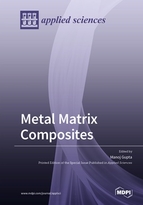Metal Matrix Composite
A special issue of Applied Sciences (ISSN 2076-3417). This special issue belongs to the section "Mechanical Engineering".
Deadline for manuscript submissions: closed (31 December 2019) | Viewed by 25398
Special Issue Editor
Interests: metal additive manufacturing; processing; characterization; lightweight materials; nanocomposites
Special Issues, Collections and Topics in MDPI journals
Special Issue Information
Dear Colleagues,
Metal-based composites provides a unique dimension in tailoring the properties of metals through the selection of type, size, and amount of reinforcement. The properties of metallic matrices, therefore, can be tailored depending on end applications. In view of the dynamic capabilities that can be exhibited, this Special Issue will cover all aspects of “Metal Matrix Composites” including: Synthesis (solid, liquid, 2-phase and 3D printing), secondary processing, properties (tensile, compressive, fatigue, impact, creep, tribological, etc.), corrosion behavior and joining techniques. The main objective, thus, will be to bring the latest results in the area of metal matrix composites to the research community worldwide.
Assoc. Prof. Manoj Gupta
Guest Editor
Manuscript Submission Information
Manuscripts should be submitted online at www.mdpi.com by registering and logging in to this website. Once you are registered, click here to go to the submission form. Manuscripts can be submitted until the deadline. All submissions that pass pre-check are peer-reviewed. Accepted papers will be published continuously in the journal (as soon as accepted) and will be listed together on the special issue website. Research articles, review articles as well as short communications are invited. For planned papers, a title and short abstract (about 100 words) can be sent to the Editorial Office for announcement on this website.
Submitted manuscripts should not have been published previously, nor be under consideration for publication elsewhere (except conference proceedings papers). All manuscripts are thoroughly refereed through a single-blind peer-review process. A guide for authors and other relevant information for submission of manuscripts is available on the Instructions for Authors page. Applied Sciences is an international peer-reviewed open access semimonthly journal published by MDPI.
Please visit the Instructions for Authors page before submitting a manuscript. The Article Processing Charge (APC) for publication in this open access journal is 2400 CHF (Swiss Francs). Submitted papers should be well formatted and use good English. Authors may use MDPI's English editing service prior to publication or during author revisions.
Keywords
- Properties
- Microstructure
- Corrosion
- Synthesis
- Tribology
- 3-D printing






